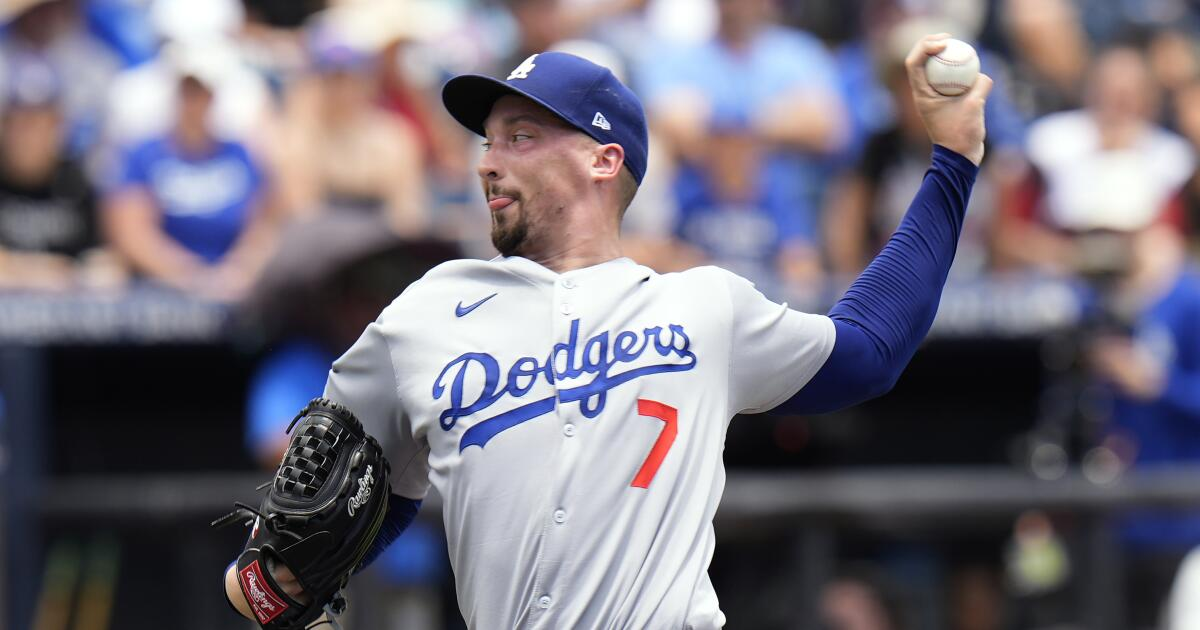TAMPA, Fla. — Blake Snell nearly had a flawless return from the injured list on Saturday afternoon.
If only the Tampa Bay Rays didn’t have slugger Yandy Díaz, or a quirky short right-field wall at their temporary home at Steinbrenner Field.
Making his first start since the second week of the season, when he went down with a shoulder injury that shelved him, Snell largely looked like the ace the Dodgers thought they were getting when they signed him to a $182-million contract this offseason.
Over a five-inning start that included eight strikeouts, no walks and a whole bunch of flailing swings by the Rays, the veteran left-hander flashed his two-time Cy Young Award-winning stuff and tantalizing late-season potential.
However, in the Dodgers’ 4-0 loss to the Rays, Snell gave up three runs on a pair of long balls to Díaz –– who twice took advantage of the ballpark’s short porch in right field.
After the Rays’ permanent home, Tropicana Field in nearby St. Petersburg, had its canvas roof shredded during Hurricane Milton this winter, the club relocated to Steinbrenner Field for this season; using the New York Yankees’ open-air, Tampa-based spring training park for its home schedule.
Since the 10,000-seat venue was modeled after Yankee Stadium in New York, its defining feature is a short right-field wall (similar to the one in the Bronx) that measures at just 314 feet down the line — eight feet shorter than the dimensions at Tropicana Field.
In the bottom of the first inning, Díaz took full advantage, golfing a 3-1 fastball the other way for a solo home run. According to MLB’s Statcast system, the ball traveled only 326 feet, and would have stayed in play at each of the league’s other 29 stadiums. But not here, and especially not on a sweltering summer afternoon with a first-pitch temperature of 91 degrees.
The first-row drive opened the scoring and it wouldn’t be the last souvenir Díaz sent that direction on the day.
Two innings later, Díaz came back to the plate with Snell seemingly in a groove, having retired seven of the next eight batters, including five on strikeouts.
However, on a 1-1 fastball that was up in the zone, Díaz launched one to the opposite field again, hitting a two-run blast on a 341-foot fly ball that would’ve been a homer in only two other parks (Yankee Stadium itself, and Daikin Park in Houston).
Frustrating results that overshadowed an otherwise auspicious day.
In the big picture, after all, the Dodgers’ main priorities for Snell are: 1) Stay healthy; 2) Pitch better than he did at the start of the season, when his bothersome shoulder contributed to two underwhelming outings that marred the start of his Dodgers career.

Down the stretch this season, the Dodgers’ biggest strength might be their rotation. Yoshinobu Yamamoto is in the Cy Young Award conversation. Tyler Glasnow has looked improved since returning from his own shoulder injury. Shohei Ohtani has showcased tantalizing talent in his return from a Tommy John procedure. And even Clayton Kershaw has been productive in his 18th season.
The biggest linchpin, though, likely remains Snell — whom the Dodgers targeted this offseason in hopes of avoiding the tightrope they walked last October, when their injury-ravaged rotation was almost completely depleted by the start of the postseason.
While the Dodgers had managed in Snell’s absence, maintaining a narrow lead in the National League West despite another prolonged stretch of patchwork pitching, manager Dave Roberts acknowledged they had missed his “presence” over the first two-thirds of the season.
Having guys like him and Glasnow back, Roberts added, could mean “everything” to the team’s chances entering the stretch run of the campaign.
“Last year, we found a way to do it, not having that [rotation depth],” Roberts said. “But having the starters healthy, pitching the way they’re capable of, makes it a better quality of life for everyone.”
Outside of the Díaz home run, Snell offered plenty of promise in his return to action.
First and foremost, he filled up the strike zone, eliminating his habit of nibbling around the plate by throwing 57 strikes in 86 pitches. And, in another positive development, many of those strikes were of the swing-and-miss variety.
Snell racked up 19 whiffs on Saturday, tied for third-most by a Dodgers pitcher in a game this season. Seven came on 12 total swings against his changeup, a key offspeed pitch that showed no signs of rust even after his long layoff. Five others were courtesy of his slider, with the Rays coming up empty on all five swing attempts against it.
It wasn’t enough to help the Dodgers win on Saturday — when their lineup managed only six hits and squandered its best opportunity to rally on Teoscar Hernández’s bases-loaded, inning-ending double-play grounder in the top of the sixth.
But it did raise the hopes about the potential of the team’s late-season rotation, offering a glimpse of the dominance the Dodgers will need out of Snell the rest of the year.
“I think this is sort of what we envisioned,” Roberts said, with his pitching staff finally looking closer to its original design. “It hasn’t been linear, like it ever is, as far as how you get to a place. But … signs are kind of looking like the roster we all intended.”
